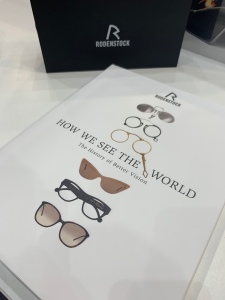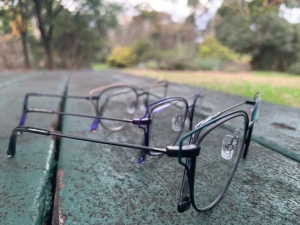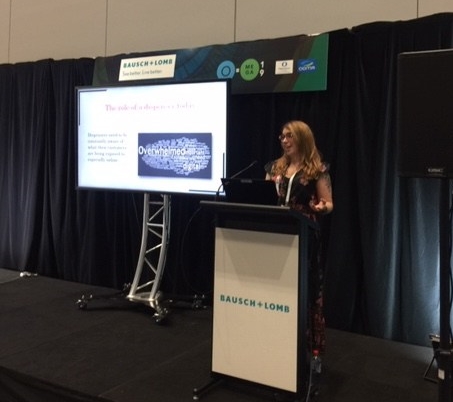These days
Being an Optical Dispenser in 2019 is extremely underrated. We deal with the day to day running of a store, keeping up with changes within the industry, health care policies and procedures, fashion and new products (all fun btw). However, we now also face the challenge of a rapidly changing customer base. Dispensers need to be constantly aware of what their customers are being exposed to more so than ever before.
The internet has opened up a platform for everyone to be a salesperson now. For example, brands can sell themselves how they want to and the customer you used to talk to about frames now comes in and tells YOU about that very same product.
Whether the information they have gathered is correct or not, doesn’t actually matter to them. The internet has given our customers knowledge, but it’s given them only part of the information they need to make an informed decision about a product. It hasn’t educated them in what could be the right decision for their independent personal needs. It’s ultimately given them power, and put us as dispensers and business owners back a few steps.

Who are we?
In most cases, whether we like to admit it or not, a lot of our customers don’t see Optical Dispensers as professionals anymore, but as salespeople. And in some cases this is true – there are people in our Industry being referred to as ‘Dispensers’ that don’t have any formal or technical training which is making it extremely difficult for those of us who are actually qualified.
Those practices who are lucky enough to have a customer base that’s been built up over the years will find that the trust built over time with this group means they are less likely to be effected. But it’s the new customers that we are all struggling with.
This is not limited to just one group either. It’s the shoppers. The bargain hunters. The fashion conscious. The millennials. The customers that get a tiny bit of information, learn one new word and then call themselves an expert.
So, how do we combat this?
How do we get potential customers to believe that we have their best interests in mind and are not ‘pushing’ or ‘selling’ particular gimmicks like ads online?
- We have to re-establish our profession.
- We have to figure out a new way to gain our customers trust.
To do this we need to start by learning to listen again, and we need to speak our customer’ s language and educate them, not just on the products that we recommend for them , but on the overall industry .
None of this is new. I’m not talking rocket science and we have all heard these points before. However, there has been a massive shift over the past 5-10 years in how our customers communicate with dispensers in store, and if we don’t recognise this and act on it now we as an entire industry and going to lose even more footing than we already have.

The art of listening
So, let’s take a look at how we listen. Obviously, what are they actually saying? They “…want a black frame, but not that black, the other black with less black detail, like that one, but do you have any blacker?”
We’ve all had a customer like this – So. Much. Fun.
We need to keep our customers talking until we are both on the same page. Giving examples is a great idea, and referencing what they are currently wearing works well. When dispensing optical frames one of the worst things you can do is go straight to the frames to look, as this can be overwhelming to a customer and can confuse what they really want.
Take your time more than ever, and talk before you look at frames.
– “I love that colourful handbag you have! Are you thinking something with a similar pattern for your new glasses?”
– “What have you loved about the glasses you’re wearing now?”
– “ We have a lot of black frames in stock, let’s try to get a little more specific with the shape and detailing you prefer before we try too many on”.

Talk their talk
If you have listened to your potential customer effectively, you should have an idea now of what they want their outcome to be, why and what kind of communicator they are. Talking to a customer about what you recommend based on what they have worn before, or what the Optometrist suggested is no longer enough. (Sorry to all the Optoms out there!)
Basically, we are all starting with the image of being overpriced, no matter what we actually have to offer. Our challenge is to break this thought pattern right from the first moment our customer walks in. So, how do we communicate with new customers effectively? We need to mimic their body language so they feel comfortable. We need to use terminology that resonates with them- which you should have picked up by listening to them. Most importantly: we need to be able to communicate VALUE.
Let’s use first time wearers as an example. Chances are they haven’t looked online in too much depth as yet because they’re still in that headspace of ‘it’ll never happen to me’.
So you’ve built up a great relationship with them, they’re nodding their head at all the right times, you’ve made sure they understand what their glasses will be for *Nodding head*
The coating the optometrist recommended *Nodding head*
Are they happy with the frame they’ve selected which happened to be the second one because it’s one of our best sellers and it’s black and you made sure it fits them *Nodding head*
Unfortunately, despite their head nodding, you’ve lost them. They may keep the purchase this time, but chances are they will now google ‘their glasses ‘ or what looks similar to them depending on how well you have explained their product to them, and find that they’re online somewhere else for half the price. Or their friend will say “Why did you go there? I got two pair for half that price at _____.” So that customer will likely not come back. Why not?
Because you’ve fixed a problem they didn’t know they had, not created value in something they need.

The inner voice
Let’s look at a hypothetical situation, and what your customer is likely thinking, vs saying.
- You start by saying ‘Right, let’s look at getting your new reading glasses selected’.
They think: ‘I don’t read a lot, maybe I could get them from the Chemist’
- When discussing photochromic options, you explain there is an extra charge to consider for this lens type
They think: ‘I’m sure Judy said she got two pairs for less than this frame costs alone’.
- You say that you will include blue control coating the Optometrist suggested in the quote
They hear: ‘Optometrist suggested…blue lenses?’
- They nod their head when you ask if they’re happy with the selected frame
They think: ‘I have absolutely no idea about what looks good and I hate people looking at me, I’m just going to say yes so I can get out of here…’
Explanation is key, and getting your timing right supports this. You need to take the time to:
- Explain the reasons a frame does or does not fit
- The bridge fit and type
- The pro’s and con’s of the frame materials
- Honest feedback on frame colours against different skin tones
- Exactly WHY what you are recommend will be better than the things that caused issues for the customer than their last pair.
Trust is everything. The more you can demonstrate knowledge and explain it to your customer in a way they can apply it to their life, the more trusting they will be of you and your advice. If we give our customers information, specific to their lifestyle and along the lines of what they have communicated is important to THEM, we are creating value in ourselves as Dispensers, and of our recommendations. Then give them a choice.

Your customer’s choice
Offering a choice in today’s market is easily the best way to close a sale. If you have done all of your preparation correctly, in reading the customer and conveying value to them in a way that they understand, you won’t lose anything by letting them choose.
Offer them their ‘Customised’ option, and then a ‘Basic’ option, which could be a more basic lens design, with or without lens coatings etc. Show your customer that although you have been discussing a premium product, you have options for them and they are in control. This is what is most likely to get you a return customer, which is what is important in the long run. When your customer then finds similar frames or options for less, be it online, through friends on general advertising, they know that they chose value over price.

Be proud of your passion!
We don’t want to compete with cheap online sales, or money hungry corporate chains. Our own blood, sweat and tears went into creating a business in this industry because we actually care. We want to help people.
The one thing independent practices have over all of the corporate groups is our ability to connect with our customers and actually get an outcome for them which is both what they want, AND what they need. We’re flexible, we have time, and we can customise their experience from beginning to end in a way no online sale or corporate machine can.
We are all in this industry and in our jobs because our customers matter to us. Quality matters to us. Premium vision care matters, and at the end of the day all we want is for our customers to leave our stores being happy and confident with their outcome, no matter what it is.
We just need to speak their language so they see that too.
The Eyewear Girl
@theeyeweargirl
For more information on any of the above points, please email me at
theeyeweargirl@gmail.com



